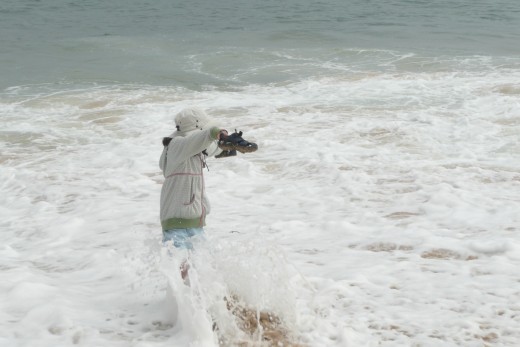How to Motivate Yourself When You Feel Defeatist
Using The Sedona Method can help overcome feelings of defeatism
You are standing on the edge of a swimming pool, trying to pluck up courage to jump in. “Come on,” you say to yourself. “You can do it. There’s no need to be scared, just jump.”
But fear wells up in you, and you go on standing there.
A little kid comes up and jumps straight in.
“If he can do it, so can you,” you think. “Stop being such a scaredy cat.”
But still you don’t jump. You look down at the blue water, and it seems so far away. “It’s easy for that kid,” you think. “He was probably never pushed in by his older brother like I was. That’s why I get so scared. It’s not my fault. I can’t help it.”
You turn away from the pool, and your mind is spinning. “But that was years ago. I really should be over it by now. I’m just making excuses. I should do it. I’m just a wimp. Everybody else can do it, so why can’t I?”
Still you go on standing.
Many of us go through life this way, hovering on the edge, taking a few steps towards our goals – you got to the poolside after all – but just not quite going all the way we need to for success.
On the Edge

Let’s take a closer look at the things you said to yourself in this imaginary scene to try to make yourself leap. They are similar to the things most of us say to ourselves daily to try to motivate ourselves into action when we feel afraid. They are also similar to things parents and teachers say to kids to try to motivate them into doing things when they are afraid. Guess where you learned to think that way?
Until around the age of six, children are constantly absorbing words and attitudes from those around them. As little children we interpret what others say and do and make meanings from those words and actions.
How your childhood experiences affect you now.
Let’s go back to those first few sentences that you used to try to motivate yourself.
You can do it. There’s no need to be scared, just jump.
Is there any person on this planet who wasn’t told things like that as a child? It sounds innocuous doesn’t it?
But let’s go back in time. You are now a little child, and someone big has asked you to jump in some water. You feel frightened when you look down and it seems so far away. Maybe you even remember jumping in before, and the water went up your nose. You were scared then and you feel scared now. But this big person (who could be a parent or teacher) has told you there is no need to be scared. That must mean that either:
(a)they are lying
or
(b)there’s something wrong with you
Since this big person (especially if it’s your parent) is someone you depend on, you want them to like you and you to like them. In fact it doesn’t even feel as you want that, it feels as if your survival depends on it. And in a way that’s true, since you are far too small to go out and get a job and look after yourself.
So the first meaning feels far too dangerous. If it comes into your mind at all you instantly dismiss it. You need the person looking after you to be telling the truth.
This leads you to form the belief that there is something wrong with you.
Or, more likely this reinforces the belief; since by the time most children get to the edge of a swimming pool they have already encountered situations in which it seems that their parents are saying they aren’t good enough.
And when children repeatedly hear: “There’s nothing to be scared of,” or any other words that are in direct conflict with what they feel, it creates internal conflict. Our minds don’t like internal conflict, so they look for some way to end it, even it that is to believe there is something wrong with me.
Of course the relief that brings is only temporary, possibly lasting a few seconds, because the next thought that comes is: and I need to change myself. This is especially true if the adult tries to get the child to do something by pointing out that other children are doing it.
So thirty, forty, fifty years later, you are still saying to yourself, “See that little kid can jump into the pool so it’s not scary and you should be able to do it.” This is followed by thinking, “But I can’t, and it means there’s something wrong with me.”
This push-pull is very stressful and leaves us feeling stuck. So the next action we take is often to try to get rid of it, to force ourselves beyond it, to just “Do something!” Even if that something is to give up and walk away.
If we choose the giving up and walking away solution, we start to see ourselves a failures. Defeatist. Hopeless. Challenges feel insurmountable because we don’t think we have it in us to start them let alone see them through.

Changing Perspective
So let’s look at this in a different way. What if instead of defining the “problem” as being an inability to jump in, we define it as needing to ease the internal stress we feel when attempting challenges. Or simply easing the internal stress we feel. In that context walking away is just as good a solution as jumping in. Both only last a short time unless the internal conflict is resolved. And that after all, is really our true goal. We want to be able to do things so that we can feel good about ourselves and have a sense of self-worth, not so that we can feel terrified and useless every time we do it.
So how do we do that?
I’ve spent time observing this in both myself and in others, and for a long time it puzzled me why facing a fear and taking action did not change that fear, did not make the action easier next time. My kids have sometimes take part in swimming competitions and would be terrified every time. I thought perhaps it was because they didn’t do many of these competitions, but then a parent whose daughter competes frequently told me her daughter vomits before these events. This mother had been a competitive swimmer as a child and had the same reaction. I’ve also heard of actors who, even after decades of practice, still feel petrified every time they go on-stage. A friend of mine joined a public speaking group because she wanted to conquer her fear of public speaking, but years later each time she stood up she felt as terrified as before. So practice does not always ease fear.
My friend stopped going to the group, and a while later she was at a meeting in her village when someone asked a question to which she knew the answer. Without thinking she stood up and spoke to a large gathering of people and only later realized that she hadn’t felt the least bit afraid.
Sometimes we need to get out to give ourselves time to heal

Observing and Welcoming
In between leaving the speaking group and this meeting, my friend had learned The Sedona Method, a technique in which you observe or welcome your feelings and the related thoughts and images that come into your mind. There’s a little more to the method than that, but for now let’s start with observation.
In this sense it means noticing without judging, and welcoming means doing that more enthusiastically. (Sometimes it helps me to remember that all my supposedly negative thoughts and feelings are coping strategies I learned when I was under six.)
So let’s go back to that swimming pool edge. You notice fear. You could say to yourself, “I feel afraid right now.” That’s observing. Then you welcome the fear: you might say to yourself, “It’s okay to feel fear.” Or you could think of the little child you once were and acknowledge that this fear is something you learned long ago and has nothing to do with right now. The point simply is to find whatever way works for you to allow yourself to feel the emotion, instead of the more usual reaction of trying to get rid of it and force yourself into action.
After you’ve done this a few times you will not be so afraid of your fear and will be more able to welcome it – this is one action that really does get easier with practice! What we fear most is fear itself, so we try to avoid it, to get over it, to force ourselves through it – anything but feel it.
This doesn’t mean we should give in to fear or avoid taking action because of it. But there are other ways to get into a pool besides jumping. Sometimes, as my friend did, removing ourselves from a stressful situation is a good idea – so long as we then take action to heal our fears. Otherwise they will just surface again in another setting.
When we are ready we can jump in easily

The Sedona Method on Amazon

Push-pull feelings
Back on poolside, you have welcomed your fear. Now you notice an urge to do something about it – first to push it away. This comes up in that sentence: “There’s no need to be scared, just jump.”
And then the next urge is to cling on it. Often we do this by justifying, and making up stories. In this case it is: “He was probably never pushed in by his older brother like I was. That’s why I get so scared. It’s not my fault. I can’t help it.” It can be a little hard to grasp that idea that we “make up stories” so let’s look at that first sentence. You have no idea what the little kid has been through, but you have made up a story that he didn’t get pushed into a pool like you did. That leads to feeling justified in feeling fear. At least it does for a moment, until the next wave of self-attack begins.
The temptation now is to try to stop having this push-pull feeling, to force yourself to relax and make a decision. Right, have you ever been able to force yourself to relax?
No?
Me neither. And trying to do so just puts you back in the same mind-set that got you stuck at the edge of the pool in the first place. On the other hand, while you’ve been welcoming your fear you showed real courage. It takes courage to allow yourself to feel fear, far more courage than it does to keep trying to get rid of it using the same methods that haven’t worked so far. And that courage will transfer to other areas of your life, so that taking action becomes less daunting in general.
Allowing the push-pull feelings
So what you do now, is to welcome all those push-pull feelings. Again, if it helps to remind yourself these were coping strategies you developed as child to try to gain approval or protect yourself, then you can do that. But it’s best not to make this into an intellectual exercise, and to really allow yourself to feel those urges to push or to hold back.
Back on the poolside, by now you may have noticed that this inability to jump feels very personal to you. In this case that is revealed in the thought: “But that was years ago. I really should be over it by now. I’m just making excuses. I should do it. I’m just a wimp. Everybody else can do it, so why can’t I?”
Again, the usual urge is to become defensive, to fight how personal it feels – because this can feel very uncomfortable and so we want to avoid it. But taking a deep breath of courage and welcoming how personal it feels, how much it feels as if this means something about us brings us closer to self-acceptance. And self-acceptance is the key to moving beyond defeatism to live life authentically, instead of being trapped by old beliefs and behaviors that no longer serve us. When you were a little child, you created those beliefs because they seemed to keep you safe, but now all they do is cage you.
Finally you can ask yourself, “Would I be willing to let this go?”
By welcoming and being willing to let go, either of the feeling that this problem is personal to you or of the problem itself, you open the door to the cage. You may even find, as my friend did, that after practicing this for a while, the next time you face what used to be a challenge it isn’t even that. Nobody is defeatist by nature, and the more you let go of the coping strategies you learned as a child, the more you come to find your true nature.

Other articles that could help
Another way to overcome beliefs that you are defeatist is to question your thoughts. If you would like to know more about this method I recommend you read the following of my hubs:
Improve Your Quality of Life with The Work of Byron Katie
How To Use The Best Self-Help Techniques In The World To Beat Yourself
How To Respond To Constant Negativity In Relationships or At Work
How to Stop Beating Yourself Up
By Hubber Cyndi10









